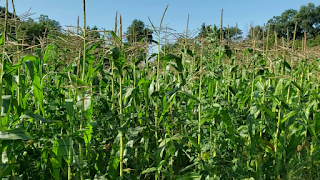Sweet corn, the iconic summer vegetable. You can hardly drive a mile in the countryside without running into fields’ worth of corn of some kind (and probably not the tasty sweet corn type). But you know right away what it is, with its tall stalks, long green leaves, and silky ears. Even in the city, farmers park their trucks, beds piled high with the golden goodness, off the shoulder of the highways and in busy parking lots to sell their crop to passersby (but the back of the truck is a hot place for corn, and allows the sugars to quickly convert to starch). Everyone loves sweet corn, which is exactly why we grow it. Richard has a saying: “Some crops you grow for profit. Some you grow to make friends. We grow corn to make friends.” How do we make friends with sweet corn? By prudently selecting the right varieties, careful planning, vigilantly combating pests, and having an expert harvest crew. If everything is done right, we will have the best sweet corn ever.
The process starts with selecting the best corn seed. Like with all lifeforms, genetics plays a vital role in the characteristics that show up in corn. All types of corn, whether field corn, decorative corn, popcorn, or sweet corn, are the same species: Zea mays. The genes needed to make corn sweet instead of starchy are recessive genes. The starchy gene is the dominant gene. Genes come in pairs, one from each “parent.” If the genes passed down from the “parents” are the same, that is the characteristic that is displayed in the “child.” However, if the genes in the pair don’t match, it is the dominant gene’s characteristic that is displayed. Take humans for example: Brown eyes are a dominant trait, blue is recessive. If both parents have blue eyes, they will have children with blue eyes. If one parent has blue eyes and the other has brown eyes, the children could have either brown or blue eyes. If both parents have brown eyes, the children could still have brown or blue eyes. It really just depends on what kind of genes the parents are carrying.
There are three recessive “sweet genes” in corn: sugary (su), sugary enhanced (se), and supersweet or shrunken-2 (sh2). Su is the oldest of the sweet corn varieties to have been cultivated. It has around 9% sugar content which quickly converts to starch once it is harvested. The short shelf life of this sweet corn is traded off for good corn flavor, mild sweetness, and a creamy texture. Se corn has between 16-18% sugar content and has a slower sugar to starch conversion rate than su corn, which means that sweet flavor is more stable. The kernels on se corn are also extremely tender; so tender they are easily damaged. Sh2 corn has about 35% sugar and has a super slow rate of converting sugar to starch. The kernels are also thick, so it stores well. However, those thick kernels also make for a crunchy eating experience. But remember how genes come in pairs? It turns out genetics isn’t exactly as cut and dry as recessive and dominant genes, and by mixing the recessive traits we can make new kinds of corn: Synergistic (su and sh2 mix) and Augmented (sh2 and se). Synergistic corn blends the sweetness of sh2 corn with the creamy texture and tenderness of su corn while giving it a long enough shelf life to do some traveling. Augmented corn does basically the same thing, just with the se corn instead of the su corn. All these hybrids were created by naturally crossbreeding the corn. We do not use any GMO altered seeds of any kind, nor do we use seeds that have “seed treatments” that contain various poisons such as neonicotinoids.
With this lesson of genetics under our belts, we pick up a seed catalogue. Farmer Richard has done plenty of trial and error, and has also learned to trust the advice of our experienced seed rep, Phil Timm. We buy all of our corn seed from the same company because of the relationship we have built with Phil. With his help, we try new corn varieties and also have been able to find our favorites: Nirvana, Sweetness, Kickoff, and Awesome.
 |
| Sweet corn in early July this year |
 |
| Sweet corn field during harvest time |
I mentioned the importance of knowing when the corn is going to be “tasseling up,” or getting ready to be pollinated to create the kernels. The pollen of corn is in the tassels. Corn takes 65 to 90 days to mature, and that range is broken into 3 different sub-seasons: early varieties (less than 70 days to mature), mid-season varieties (70-84 days to mature), and late varieties (more than 84 days to mature). If we were going to be planting different types of corn together, we would want to make sure that they were in different sub-seasons. By planting corn from different sub-seasons, we can continue to deliver corn as long as possible throughout corn’s growing season, while also avoiding the potential for cross pollination between the varieties.
 |
| Richard explaining how the fake owls work |
 |
| Richard checking the pheromone trap for earworm moths |
 |
| Richard harvesting sweet corn |
 |
| Sweet corn being iced before being stored in the cooler |
Did we achieve “the best corn ever” this year? We hope you have enjoyed this article about the iconic summer vegetable and have learned a thing or two about how we bring it to your table. With all the hard work we put into it, we sure hope we managed to make a few friends along the way by giving you a few sweet ears of our golden goodness this year!



1 comment:
Very helpful.....thank you
Post a Comment